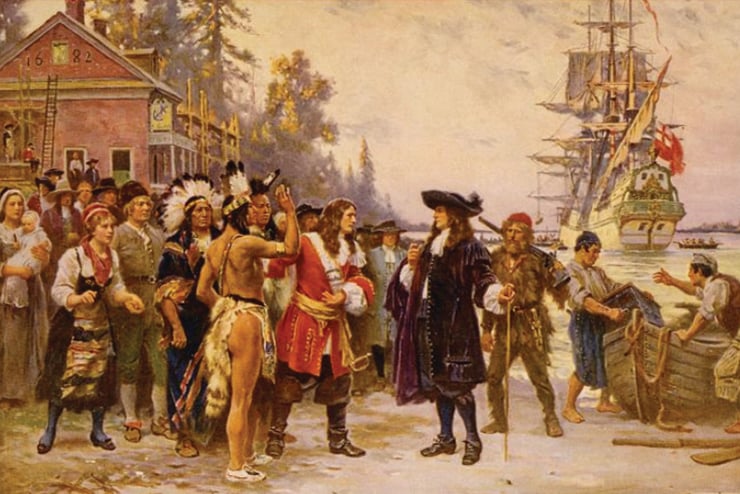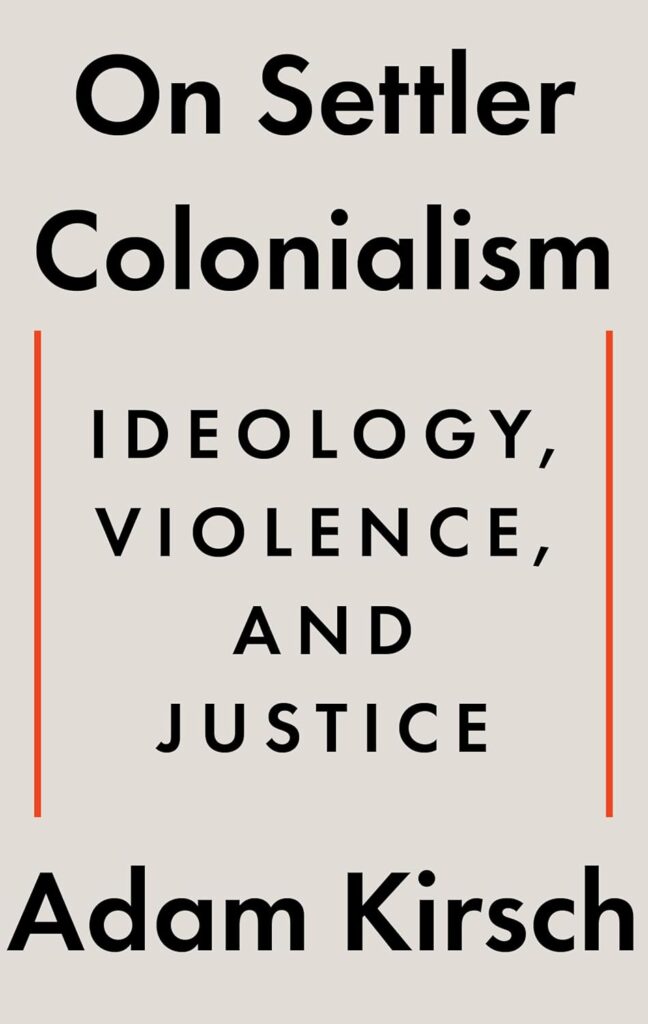On Settler Colonialism: Ideology, Violence and Justice
W.W. Norton
by Adam Kirsch
160 pp., $24.99
Adam Kirsch has written an outstanding and overdue frontal assault on the ideology of “settler colonialism.” This particular eruption of leftist insanity is nothing other than the demonization of the modern societies founded by European settlers and, particularly, by English speakers.
It’s open to question whether settler-colonial ideology is just the latest product of the demoralization of the Western world that has gone on, with few interruptions, since 1914 or whether it is an especially vicious and dangerous development. Kirsch makes a good case for the latter evaluation. Elements of this ideology have spread with remarkable ease among young Americans, particularly since the Hamas attack on Israel in October 2023. But its application to delegitimizing Israel is a relatively late phenomenon.
The full-blown settler-colonial ideology began in Australia in the 1980s as an outburst of guilt-tripping modern white Australians for the past mistreatment of Australian aborigines. Yet it undoubtedly owes a good deal to older patterns of thought, which can be found in works of writers as varied as Dee Brown and Howard Zinn. Starting as an attack on Australian society, it quickly extended to the United States and other offshoots of Britain. Latin American societies and the Russian settlement of Siberia and the southern steppes are usually passed over by the settler-colonialist ideologues. There are exceptions, such as Roxanne Dunbar-Ortiz’s An Indigenous People’s History of the United States, which dismisses Mexican-Americans as just another “settler” group.
The ideologues claim that settler-colonial societies are based on the dispossession, if not destruction, of the Amerinds, or their equivalents, rendering them permanently illegitimate and guilty of a continuing crime. “Settlement is not a past event but a continuing structure,” they explain, and every inhabitant of a settler-colonial society who is not descended from the indigenous inhabitants is, and always will be a “settler.” Settler is not a description of individuals from the past but an inherited identity. All later immigrants, not just the original colonists or their descendants, are settlers, even black descendants of slaves.
In one way, it may be a relief that these ideologues do not blame everything on white Anglo-Saxon Protestants, but even that is not reassuring. The true believers even distrust the descendants of the indigenous peoples who have sinned by assimilating to modern society to some degree or other. The fact that the native groups that have done so, such as the Cherokees, have done far better than those groups stubbornly resisting all settler influence to the last, is another matter that escapes their notice. So does the point that unmixed Amerinds are becoming fewer in number and that quite a number of white Americans have some Amerind ancestry. Every aspect of settler-colonial societies is hopelessly contaminated and evil and always will be. Assimilation or acculturation is “structural genocide” and encompasses, remarkably, granting citizenship to Amerinds (something not done until 1924!) but also “miscegenation”—an interesting use of a term widely regarded as disreputable nowadays.
These beliefs are not unconnected with the absurd picture of the pre-Columbian Americas as a paradise until the satanic Europeans came. Being indigenous is a virtuous moral and spiritual status associated with authenticity, selflessness, and wisdom, although such traits don’t seem to have been too widespread in Aztec Mexico.
And all of this, somehow, justifies violence—of any amount—against settler-colonial societies.
As Kirsch wryly points out, the thinking involved is characteristic of both 19th-century Romantic nationalist doctrines and of justifications for revolutionary violence throughout history.
The cult of indigenous virtue and wisdom also slops over into contempt and hostility for science, presenting indigenous origin myths as though they were as valid as scientific accounts. In fact, Kirsch demonstrates that the settler-colonial ideology is utterly irrational and a classic exercise in magical thinking and nihilism. It leads nowhere, or at least to no practical conclusion. At best, it evokes nothing more than hypocritical virtue-signaling. At worst, it becomes a provocation to violence.
Of course, the desire for violence perhaps came first and the ideology followed as a post hoc rationalization. Some of the settler-colonial ideology’s theoreticians blather about “reversing the timeline” and “relinquishing settler futurity,” by returning the land to the indigenous people. If that could be done (and it’s not likely it can), it would just impoverish 99 percent of the present-day inhabitants of settler-colonial societies. How all that will lead to a better world is left unspecified.
One group of settler-colonial ideologues has suggested that the destruction of Israel—possibly a more practical goal than destroying the U.S. or Canada—will ensure not only that Palestine will be free but will also rid the world of Islamophobia, anti-Semitism, anti-blackness, militarism, occupation, and apartheid. (Surprisingly, they omitted climate change, cancer, and constipation.)
This sort of thinking may evoke nostalgia for the comparatively rational thinking exhibited by Communists and Nazis. All of this fails to grasp the point, well made by Kirsch that the past and its injustices can’t be undone, and the attempt by fools to make it happen can only perpetuate, not end, wrongs.
Kirsch does not hide that he is particularly concerned about the effect of this ideology on Israel, though he is far from being uncritical of Israeli policies. He disapproves of the Israeli settlements on the West Bank. However, he points out that Israel is hardly a classical settler-colonial society. And if it has committed genocide against the Palestinian Arabs, it is a very strange sort of genocide indeed, as the current Palestinian population is several times as large as it was in 1948. Jews and Armenians would have been overjoyed to suffer that kind of genocide!
Oddly, Kirsch passes over the point that half of Israeli Jews are descended from people chased out of the Arab world, which rather discounts a simplistic picture of Israel as just another settler-colonial country. It is rather the product of an effective exchange of populations, comparable to that between Greece and Turkey a century ago.
Kirsch thinks that Israel cannot, or will not, be destroyed, as Israeli Jews are a majority, not a thin stratum of colonial administrators or a settler minority like the one that existed in Rhodesia. Israeli Jews are a large majority that has nowhere to go and will fight fiercely. One hopes he is right. As for the overseas English-speaking societies, the stupid settler-colonial fanatics Kirsch describes are not going to destroy them but will present just another demoralizing and disruptive leftist ideology among many.
This is a short book and Kirsch, regrettably, does not pursue interesting matters that he mentions in passing, notably the discovery of some of the settler-colonial theorists that the Palestinian Arabs are a “non-white people.” That seems a remarkable feat of reclassification since their appearance doesn’t differ from that of Israelis of Middle Eastern origin, or, for that matter, some of European origin. This sort of thinking, if that is what it is, might be worthy of exploration.
Kirsch also lacks some historical depth. He supposes that the term “colonialism” originally had a distinct meaning that the settler-colonial school has distorted. That is not the case. Even more than “imperialism,” for which it was often used as a synonym, “colonialism” never had a clear or stable content. He apparently buys, for example, the idea that, until recently, much American thinking about their history was really a myth, or largely a myth, tenable only as long as the country was defined solely by the experience of whites. He suggests that only after World War II and the rise of the civil rights movement did the United States begin grappling with reconciling patriotic myth with historical fact.
However, the civil rights movement is far older—originating, as it did, in the pre-World War I Progressive Era. And the histories of the treatment of relations between whites and Amerinds, and of slavery, were a lot more realistic than Kirsch recognizes. For example, James Ford Rhodes’s extremely popular and influential History of the United States Since the Compromise of 1850, first published in the 1890s, had an entirely “modern” treatment of slavery. The topic was never left solely to apologists for the antebellum South, as is widely imagined. Indeed, the earliest phase of relations between settlers and Amerinds, as analyzed by historians like Karen Kupperman and Alden Vaughan, is not quite congruent with current fashionable beliefs.
Nor does Kirsch seem to realize that the characteristics of modern societies so hated by the settler-colonial ideologues were already seen within pre-colonial medieval Europe. They have parallels in some non-Western societies as well. A bit of attention to these details might have strengthened Kirsch’s fine work. But what he does achieve in dismantling the settler-colonial ideology is noteworthy.


Leave a Reply